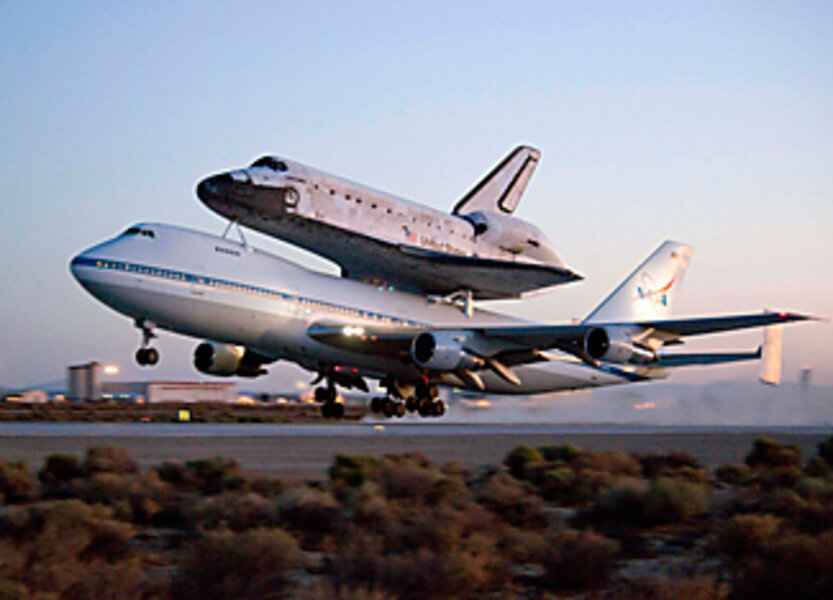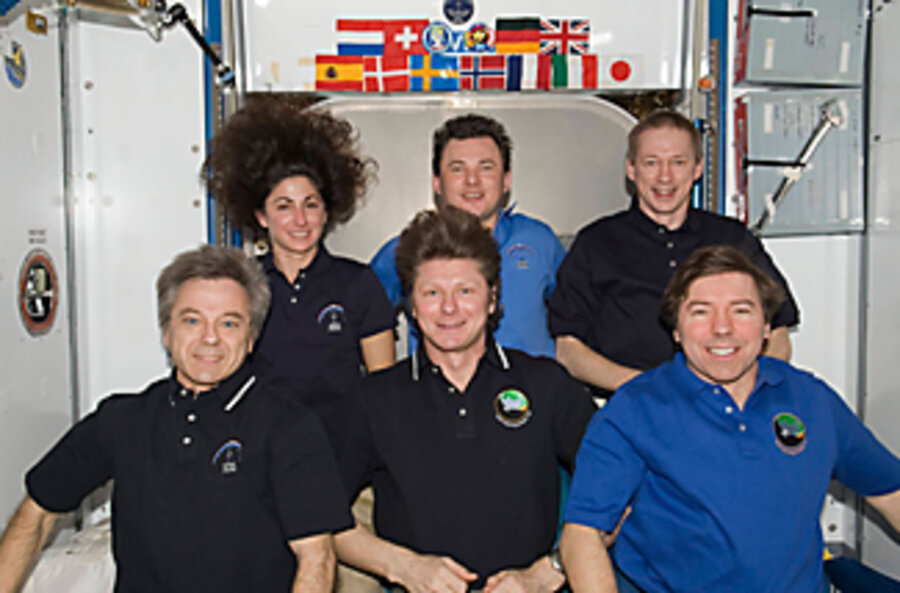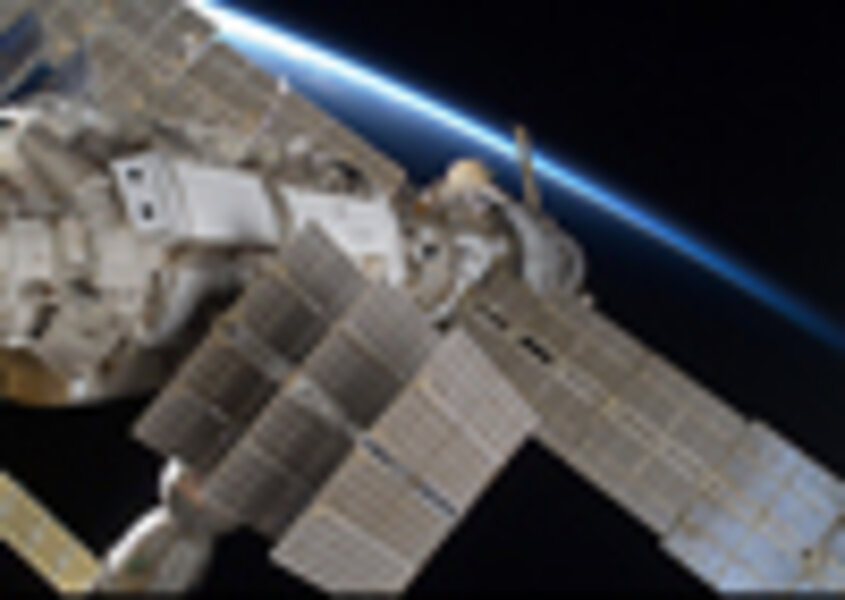Should nations fly to the moon together?
Loading...
| Boston
Ed Weiler was ready for a break. So the top scientist at NASA looked for his friend David Southwood of the European Space Agency (ESA) to join him in a respite from the second day of talks at a meeting about Mars probes, orbital spacecraft, and plucky planetary rovers. It was July in Annapolis, Md. Hot. Sultry. The two men sat on a terrace overlooking the salt-scented seaside town.
Over a Diet Pepsi and coffee, Drs. Weiler and Southwood chatted amiably about their ultimate passion – and one of the holy grails of planetary science: bringing back a rock sample from Mars. But the conversation inevitably got bogged down in the hard reality of arithmetic. Both knew it would take at least $1 billion just to land a spacecraft on the Red Planet.
Then the two men had a eureka moment: Why not have NASA and ESA team up on a venture? Not just one agency putting an instrument on another's spacecraft. An entire set of missions – jointly.
As Weiler put it: "Maybe we ought to be conceiving these things upfront, together."
The result: An announcement this past July of a pioneering agreement between the two agencies to develop a joint Mars exploration program. The effort would begin with missions in 2016 and 2018. It would reach its apex in the 2020s with the first return in the history of the human species of soil and rock samples from another planet.
The venture hatched over talk of money and Martian geology may now become a template for international cooperation in space over the next generation. As exploration of the heavens becomes increasingly expensive, many experts around the world think we have reached a hinge moment in history when joint ventures are the best – and perhaps only – way to undertake distant exploration, both manned and unmanned, of the cosmos.
And why not? The world science community has already come together to smash atoms beneath pastureland on the Swiss-French border. It has joined hands to probe distant galaxies with a china cabinet of radio-telescope dishes on a desert expanse in Chile. It is collaborating on an experimental nuclear-fusion reactor that could herald the way to producing unlimited energy. Why not send vessels together to Mars or Titan or Europa?
To a certain extent, of course, we already do. The International Space Station, by name and definition, is a collaborative project. The Cassini-Huygens mission to Saturn is a cooperative venture of NASA and the European and Italian space agencies, and the United States had a key instrument on the probe India recently ferried to the moon.
But these tend to be lone projects – a lunar water sensor supplied here, a joint satellite launch there. Some now believe it's time for true collaboration – missions jointly conceived, jointly funded, and jointly carried out – to push mankind to the next threshold of space exploration and to forge a new spirit of cooperation among nations. In other words, a sort of Star Trek Starfleet Command. They see it as the only way mankind can continue the quest, innate since the days of the caveman, to find out "what's over the next horizon."
Yet before the world embarks on any kind of cosmic Kumbaya ride, a fundamental question looms: Can spacefaring nations really overcome the impediments that have traditionally inhibited such ventures – national pride, suspicion of sharing technology, bureaucratic and cultural differences?
"We have to do it or we won't be doing the grand mission of exploration," says Louis Friedman, executive director of the Planetary Society, a space-exploration advocacy group in Pasadena, Calif.
ONE THING IS CERTAIN: Spaceflight isn't cheap, whether you're launching cameras or cosmonauts. The Augustine committee, appointed to study options for the future of NASA's human spaceflight program, reiterated this point in its report to the White House. Part of the challenge: The questions driving scientists to explore outer space grow more complicated with each mission. As a result, so does the hardware they send skyward.
Consider just the evolution of NASA's Mars rovers, the little wheeled robots that nuzzle rocks and beam back pictures of the planet's surface. Sojourner, part of the Mars Pathfinder mission in 1997, could easily sit on a large coffee table (total cost, including the launch: $265 million). The two rovers currently on Mars, Opportunity and Spirit, are the size of small golf carts (cost: $820 million for the pair). The Mars Science Laboratory, scheduled for launch in 2011, could substitute for a car (estimated price tag: $2.2 billion).
When humans are added to the passenger list instead of robots, the expenditures rise exponentially. Scientists need to make sure they leave, arrive, and return safely. And if you're talking settlements on the moon or Mars, you're adding the expense of generating power, shipping gear, and designing spacesuits and tools that can withstand unfathomably harsh environments – moon dust alone poses a constant threat since it is essentially bits of broken glass. These items don't just come off the shelf at Home Depot. One longtime estimate for a simple lunar outpost has been pegged at $33 billion. Others estimate it at $100 billion over 10 years.
The Augustine committee was predictably sober about what the US can do about sending humans into space with the money currently allotted. Yes, it said, the US can go back to the moon, as President Obama has indicated might be good. It could probably build a rocket and a lunar capsule. But without additional funding – at least $3 billion by mid-decade (NASA's current budget is $17.8 billion) – the agency would have to stretch out the program. Ares, the next-generation rocket, wouldn't be ready until just before the agency turned out the lights on the space station. There would be no money to fabricate the things needed to live on the lunar surface. Astronauts would be suited up with no place to go.
Alternatively, the commission said, the US could forgo landing on the moon and instead begin a series of launches between 2020 and 2030 to send astronauts to orbit the moon, Mars, or an asteroid. Notably, it also said that the US could expand its footprint in the heavens by leading a "bold new international effort in the human exploration of space." In other worlds, cooperation – the Starfleet Command-like approach.
Yet given the high cost of venturing into the heavens – even with multinational wallets – the question persists: Why send humans aloft at all? To some, it's simply about choosing the right tool for the job.
Robots could do just fine in environments like the moon. Steven Squyers, a planetary scientist at Cornell University in Ithaca, N.Y., told a presidential panel in August that the lunar surface was shaped by relatively simple forces and an instrument-laden rover could answer basic questions about its history.
But Mars, his speciality, is another case. Over its 4.6-billion-year life span, glaciers, vast bodies of water, volcanoes, wind, and plate tectonics have sculpted the planet. "All of this complexity means that human explorers can, in principle, contribute more to the scientific exploration of Mars than they can to any other body in the solar system," Dr. Squyers said.
And if the hunt is for life-forms, current or past, rather than just rocks, it would require deep drilling – something also better done by humans. "What Spirit and Opportunity typically achieve in a day," he said of the current robotic rovers on Mars, "a human explorer could do in less than a minute." In 5-1/2 years, Opportunity has ventured 10 miles from its landing site. Apollo 17 astronauts in their moon buggy traveled farther in one day.
Yet better science is hardly the only reason countries launch humans into space atop pillars of fire. Since the dawn of the Space Age and the cold-war rivalry between the US and the former Soviet Union, international prestige, geopolitics, national-security, and economic benefits all have been invoked to build public and political support for sending humans into orbit.
Others see a more cosmic rationale. Humans must move off the planet to endure and continue to evolve, they argue. Some suggest time may be short to do so, perhaps only a few centuries. They note that any number of catastrophic events – nuclear war, unchecked global warming, a collision with an asteroid – could imperil humans' ability to explore space. "An important bloc of the space community believes that humanity has a finite period of time to colonize other worlds before conditions on Earth no longer sustain human migration," write space historians Roger Launius and Howard McCurdy in their recent book, "Robots in Space."
HUMANITY'S FIRST STEP off the planet – and first unsuccessful stab at international cooperation in human spaceflight – took place during NASA's Apollo program.
On July 19, 1969, Neil Armstrong made his historic boot print on the moon. It was a "booya" moment in Washington's geopolitical competition with the Soviets. After all, the Russians had orbited the first satellite and the first human. President Kennedy was looking for a heat in the space race the US could win. He set out the challenge to put an astronaut on the moon within the decade in an address to a joint session of Congress in May 1961.
But less than a month later, Kennedy held a summit with his Soviet counterpart, Nikita Krushchev, in Vienna and proposed the two countries go to the moon together, according to Howard McCurdy of American University in Washington, D.C. By then, the president had seen intimidating cost estimates for a man-on-the-moon effort. A partner could help share the expense and perhaps allow Kennedy to ease up on the ambitious timetable.
Krushchev first said nyet. Kennedy pressed. The Soviet leader came back and said: Disarmament first, then we can do it. Kennedy thought it was a ploy to discourage a joint lunar effort. But the Soviet leader was serious, Dr. McCurdy notes. The US might be able to pay for an arms race and a trip to the moon, but Krushchev knew the Soviet Union couldn't.
Kennedy extended the hand once more in his address to the United Nations in September 1963. Two months later, he was assassinated. It would take a different president and another 12 years before the US and Russian astronauts mated an Apollo spacecraft with a Soyuz capsule in the first cooperative human-spaceflight project between the two countries.
Today, the picture has changed dramatically. The cold war is over. The Russians have made major contributions to the International Space Station, joining the Americans, Europeans, Canadians, and Japanese as the project's lead partners.
The notable new entrant in human spaceflight is China. Beijing has launched three manned orbital missions in the past six years. The latest venture, in December 2008, carried three astronauts into orbit. Two of them conducted China's first spacewalk.
India, meanwhile, plans to launch its first astronaut sometime between 2014 and 2015. If successful, it would become the fourth country with the ability to launch humans into orbit.
All this is one more reason some think the time is right for a new era of cooperation in space. So many different countries now have something to contribute to the voyage.
Evidence of this was a pact signed in 2007 by 14 space agencies, including ones representing countries outside the traditional cast of rocketeers: China, Australia, South Korea. Dubbed the Global Exploration Strategy, the agreement envisions cooperation on a range of levels – from simple two-country projects to complex space-station-like efforts. It also encourages nations to build vehicles and equipment by using common design standards. Preliminary work was under way on the standards for lunar hardware when the Obama administration called for a review of NASA's manned spaceflight program.
FORGING NEW partnerships in space won't be as easy as saying, "Beam me aboard, Scotty." One reason: the cultural differences in the way countries approach space. For instance, Walter Peeters, dean of the International Space University in Strasbourg, France, recounts how the US acclimates astronauts to weightlessness versus the Russian way.
To overcome motion sickness that can occur when astronauts are in orbit, the US takes the pharmaceutical approach: It gives astronauts pills. The Russians, on the other hand, will spin cosmonauts in special chairs for longer and longer periods of time to help them adapt ahead of time. "They [the Russians] have a very mechanical culture," says Dr. Peeters. "Everything that docks or clamps goes bang or boom – it makes a lot of noise."
Each country brings its own idiosyncrasies as well as intelligence to the drafting table. Peeters notes that the Russians have always tended to be far more wary of having computers control spacecraft than the Europeans or Americans. That stems from the country's historical lack of computing prowess compared with the West's. Similarly, in the US and Europe, engineers rely much more on systems like global positioning satellites and electronics in triplicate when operating space vehicles.
"That is a bigger stumbling block than most people think," says Peeters.
Nor are the cultural differences limited to just nuts and bolts. When the Russians first joined the International Space Station effort, Westerners were shocked that Russia made the medical records of its cosmonauts public – unlike in the US, where such files are strictly confidential.
Politics may be an even bigger impediment to cooperating in space than cultural factors. Some analysts outside the US wonder how sincere NASA is about working with other countries on major projects, such as manned missions to the moon or Mars. "Americans are very self-sufficient people," says Igor Lisov, a columnist for Novosti Kosmonavtiki, a leading Russian space-science journal. "They still think they can return to the moon by themselves. Only recently have they begun to think twice about that, and they still aren't asking for help."
China represents another player whose seat at the drafting table is uncertain, especially in US eyes. In 1999, a panel set up by the US House of Representatives concluded that China had stolen US nuclear and other secrets. This prompted Washington to veto China's participation in the International Space Station. [Editor’s note: The original version implied that Brazil got the invitation to join the International Space Station when China didn’t. Brazil was already on board, having joined the ISS effort in 1997.]
An international spaceflight effort involving China and the US "is not going to happen" for the foreseeable future, says Eric Hagt, who heads the China program at the World Security Institute in Washington.
Nor is the US alone in being wary. Peeters notes that Europe also has concerns about Chinese guardedness with space technology. "Very valid concerns about China's goals in space" exist, says Joan Johnson-Freese, who heads national security studies at the US Naval War College in Newport, R.I. "The Chinese are so stingy with sharing any information that it is very easy to suspect the worst. The Obama administration is far more amenable to working with China, but they will have a problem with a small but very vocal group in Congress." Still, she adds, "We have to stop ignoring the fact that there is a third manned spaceflight program out there."
The Obama administration's overtures to China on other issues leads Jiao Weixin, a professor at the School of Earth and Space Sciences at Peking University, to conclude that "there will be more and more opportunities to cooperate" in space. "Cooperation requires mutual trust and something useful from both sides," he says. "China can make a contribution that it could not make 10 years ago, and its international relations are improving."
While political differences may keep nations from teaming up in space, teaming up in space can be a powerful force in reducing political tensions. Roger Launius, a former NASA historian and curator of the Smithsonian Institution's Air and Space Museum in Washington, notes that when the Clinton administration pushed to bring Russia into the space station partnership, the objective had little to do with the cosmos and everything to do with foreign-policy objectives. At the same time, however, it was clear Russia had experience and skills to bring to the partnership. "It's a way of bringing our allies into things and making allies of nations that weren't allies in the past," he says.
That might seem quaint in the absence of the cold war. But he suggests that this aspect of international cooperation in human spaceflight may be just as important today.
Writing in the journal Astropolitics, Dr. Launius notes that if post-cold-war conflicts now represent a clash of civilizations, rather than a clash of two superpowers, cooperation in space could become an avenue for building alliances and cooperation among peoples. Scientific knowledge, breakthroughs in technology, and freeze-dried foods may be good reasons for heading beyond low-Earth orbit. But some of these traditional justifications "may well pale in comparison with the very real possibility of enhancing cross-civilization relations through this one act of working together to tackle an enormous challenge."
Someone summon Captain Kirk.
r Contributing to this report were Peter Ford in Beijing and Fred Weir in Moscow.








